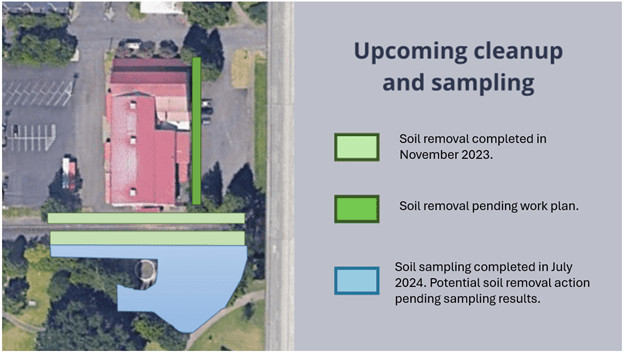Recent environmental investigations have revealed polychlorinated biphenyls (PCBs) contamination in the vicinity of Bradford Street, specifically around Cathedral Park and Peninsula Iron Works. PCBs, once widely used industrial coolants and lubricants, were banned in 1977 due to their harmful effects on human health and the environment. The Oregon Department of Environmental Quality (DEQ) is actively managing the cleanup process to address this contamination and ensure public safety in the Bradford Street area.
To minimize potential exposure in the Bradford Street vicinity, DEQ and the Oregon Health Authority (OHA) recommend the following precautions for individuals in the affected area:
- When crossing the railroad tracks, remain on the paved path.
- Avoid walking along the railway line.
Bradford Street Cleanup: Project Status
Updated: October 2024
September 2024: Following preliminary findings from soil sampling conducted in July 2024, further, deeper soil samples were collected within Cathedral Park. The laboratory analysis of these samples is currently underway. The data gathered from both the July and September sampling events will be crucial in defining the precise area requiring soil removal within the park to effectively address the Bradford Street contamination issue.
July 2024: Peninsula Iron Works carried out additional soil sampling in Cathedral Park to further assess the extent of PCB contamination. The results from the analytical review of these samples are still being evaluated.
For a more detailed understanding of the project’s history and timeline, please continue reading below.
Next Steps: Contamination Removal Actions
Peninsula Iron Works is currently developing a comprehensive cleanup work plan based on the findings from the Cathedral Park soil sampling. This plan, which will be submitted to DEQ for approval, is expected to outline strategies for soil removal and replacement in contaminated areas. The planned cleanup may involve removing soil from the landscaped area adjacent to the southern wall of Peninsula Iron Works’ building, and potentially from areas within Cathedral Park impacted by the Bradford Street contamination. The scheduling of this crucial work is currently being finalized.
 Map outlining the cleanup and sampling zones at Peninsula Iron Works and Cathedral Park, relevant to the Bradford Street contamination issue.
Map outlining the cleanup and sampling zones at Peninsula Iron Works and Cathedral Park, relevant to the Bradford Street contamination issue.
Once DEQ has received and analyzed the complete sampling results from Cathedral Park, a community meeting will be organized. This meeting will serve as a platform to share the findings with the public and discuss the subsequent steps in the Bradford Street cleanup process.
DEQ is committed to progressing this project as efficiently as possible while ensuring the community remains well-informed throughout every stage. To stay informed about the Bradford Street project, you can utilize the following resources:
- Subscribe to our email update list for direct notifications.
- Connect with the Portland Harbor Community Coalition at [email protected]. They are actively involved in coordinating community engagement efforts related to this cleanup.
- Regularly check this webpage for the latest updates and information.
 Sign posted near Bradford Street advising park visitors to stay on designated paths when crossing the railway due to potential contamination.
Sign posted near Bradford Street advising park visitors to stay on designated paths when crossing the railway due to potential contamination.
Currently, signs are posted along the railroad corridor to advise park visitors to stay on the designated paved path when crossing the railway tracks, as a precautionary measure related to the Bradford Street contamination.
DEQ has been actively engaging with community members since October 2021. The expedited progress of the Bradford Street cleanup, the installation of warning signs, and the allocation of funding for this project are all outcomes of this ongoing community collaboration.
Further Background Information on the N. Bradford Street Cleanup
Additional Context on the N. Bradford Street cleanup initiative
2022: DEQ secured funding from the U.S. Environmental Protection Agency (EPA) to conduct comprehensive soil sampling in Cathedral Park, focusing on the area near the railroad where preliminary data indicated potential contamination. DEQ and OHA held community meetings in July of that year to present and discuss the initial findings of this sampling effort.
The 2022 sampling provided encouraging results in several key areas:
- PCB levels were found to be below DEQ’s long-term park user screening levels in ten sampling locations, including the dog park area. This indicates that PCB concentrations are sufficiently low to pose no significant long-term health risk in these zones.
- In a specific section of the park, PCB levels exceeded DEQ’s long-term park user screening level but remained significantly below levels that would trigger immediate health concerns. OHA determined that these PCB concentrations still presented a low health risk because the soil is covered by grass and mulch, and park users typically do not spend prolonged periods in any single location within the park.
- As a precautionary measure, OHA recommended that the City of Portland Bureau of Parks and Recreation implement a regular inspection and maintenance schedule for the grass and mulch cover in the affected area. Maintaining this ground cover helps to minimize potential contact with bare or loose soil. The City has been actively following this recommendation.
- DEQ has committed to ongoing sampling throughout the cleanup process to continuously evaluate contamination levels and refine the most effective strategies for addressing the Bradford Street contamination.
February 2023: DEQ again received funding from the EPA to support continued soil sampling in Cathedral Park near the railway line, further investigating areas known to have some level of contamination related to Bradford Street. DEQ and OHA continued their community engagement, meeting with residents in July to discuss the results of these subsequent sampling efforts.
March 2023: DEQ received updated sampling data collected by Peninsula Iron Works and Union Pacific Railroad within the Bradford Street area. DEQ and OHA jointly analyzed this new data, which confirmed the existing understanding of the areas with higher concentrations of PCBs in the soil.
The March 2023 sampling results indicated the following:
- DEQ and OHA concluded that there was no immediate health risk associated with short-term contact with the soil in the Bradford Street vicinity.
- The highest PCB concentrations were consistently found along the railroad right-of-way adjacent to Peninsula Iron Works. Soil concentrations in this area exceeded DEQ’s acceptable screening levels for long-term, repeated exposure for both workers and park users. The recommendation to avoid walking along this specific area remained in place.
- In one part of Cathedral Park, PCB levels were found to be above DEQ’s screening level. In response, the City of Portland Bureau of Parks and Recreation increased the mulch cover in this area, and OHA reiterated the recommendation for regular inspection and maintenance of the grass and mulch as an additional safety precaution.
May 2023: DEQ and Peninsula Iron Works formalized a consent order to specifically address areas with the highest PCB concentrations near Bradford Street. As an interim measure, Peninsula Iron Works placed a temporary cover along the railroad right-of-way to reduce potential public contact with contaminated soil while a comprehensive, long-term cleanup solution was being developed.
May and June 2023: DEQ and OHA conducted further community meetings to share the findings from the updated sampling data received in March 2023 from Peninsula Iron Works and Union Pacific Railroad. Detailed sampling plans and reports are publicly accessible on the dedicated technical documents page.
August 2023: DEQ approved the comprehensive cleanup work plan submitted by Peninsula Iron Works. This plan detailed the removal of contaminated soil from the railroad right-of-way bordering the Peninsula Iron Works building and along the southern wall of the building itself, areas significantly impacted by Bradford Street contamination.
November 2023: Peninsula Iron Works executed the initial phase of the cleanup work plan, removing contaminated soil from the railroad right-of-way adjacent to their building. A geotextile fabric was laid at the base of the excavated area, and the excavation was then backfilled with clean gravel to prevent future exposure.
Learn More About the Portland Harbor Superfund Site Work Nearby
It is important to note that the Bradford Street cleanup project is distinct and separate from the Portland Harbor Superfund Site remediation efforts. The EPA is also undertaking work within parts of Cathedral Park as part of the broader Portland Harbor Superfund project. More information about the Portland Harbor Superfund Site is available on EPA’s storymap. For specific details regarding the Cathedral Park component of the Superfund project, please visit EPA’s project webpage and Oregon Health Authority’s page for that project. To get involved in the Superfund work at Cathedral Park, please contact EPA Community Involvement Coordinator, Laura Knudsen. DEQ regularly updates the EPA on the progress of the N. Bradford Street project, ensuring coordination and information sharing with community members involved in the Cathedral Park Superfund work.
Project Contacts
Project Manager
Rebecca Digiustino
503-926-2257
Community and Media
Michael Loch
503-737-9435
Oregon Health Authority
Todd Hudson
971-599-0372

